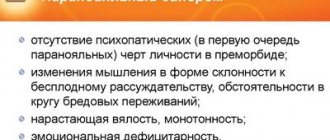Severe neurosis and asthenic neurasthenia
Reactive severe asthenia can occur with severe neuroses. The disease is complemented by the following clinical signs:
- absentmindedness;
- forgetfulness;
- autonomic disorders - unexplained difficulty breathing, sweating, changes in blood pressure, increased heart rate;
- high level of anxiety;
- increased fears and phobias;
- decreased sex drive;
- fluctuations in appetite;
- increased sensitivity to bright light and loud sounds;
- impaired speed and quality of thinking (cognitive dysfunction);
- concomitant depressive (affective) clinic.
However, the diagnosis of neurasthenia has now lost its relevance; it was removed from the ICD 11th revision (2019). The problem lies in the inaccuracy of the pathogenetic mechanisms, and the symptoms can be placed within the framework of other diseases and conditions.
In adult men
The course of affective disorders is individual, the dependence on gender is almost not expressed. However, men may have other prerequisites for developing the disease. For example, they more often become participants in hostilities or suffer financial (career) failures more difficult.
The social roles that are imposed on boys from an early age increase the demands placed on themselves. Young men start working earlier in an effort to achieve success, which exposes them to high levels of stress. We must not forget that personal characteristics are different for all people, that is, not everyone can withstand the pressure applied.
Over the years, the condition worsens due to chronic fatigue, family problems, and aging. Losing a job or wife in middle age often becomes a critical moment when adaptation mechanisms are disrupted. At the same time, men are less likely to go to doctors, not wanting to show their own weaknesses, or even completely deny the existence of a problem.
Among women
Now women are trying to share the same social functions as men, while caring for children and maintaining everyday life. An exaggerated sense of responsibility leads to them taking on too many responsibilities. Unofficially, psychiatrists call this the “hunted horse” syndrome.
Prolonged intellectual and psychophysical overstrain becomes a trigger for the development of affective disorders. Another common cause of asthenic depression in women is the pre/postpartum period. Violations are aggravated against the background of hormonal imbalance, as well as in the absence of support from loved ones.
In children
Unfortunately, children are also susceptible to developing the disease. The normal development of the psyche largely depends on obtaining a positive emotional experience, adequate upbringing, and a “healthy” social environment. Vulnerability is determined not only by age, but by a person’s personal characteristics.
Children may experience all the symptoms characteristic of asthenic depression. However, they cannot always correctly formulate their concerns or are completely silent about them. The painful condition is hidden behind complaints of boredom, strange pains, and restless sleep.
As the disorder worsens, the child begins to distance himself from others, stops taking part in games, and moves away from peers. A decline in academic performance leads to conflicts in the family and school. It is not uncommon to skip classes, run away from home, and spend time alone.
The appearance of depressive behavior at a young age should alert parents and teachers. Children often remain silent about bullying at school, cases of violence (including sexual violence), and disharmonious relationships in the family. Lack of timely treatment causes delayed psychomotor development, the occurrence of more severe diseases, and suicidal behavior.
What is asthenic syndrome, asthenia?
Asthenic syndrome is a syndrome characterized by a state of mental irritable weakness, rapid depletion of nervous processes, unstable mood, impatience, decreased performance for prolonged physical activity and mental stress, intolerance to bright light, loud sound, strong smell, emotional lability, and sleep disturbances. The term " asthenic syndrome " comes from the Greek word "astheneia", which means "weakness, impotence". Asthenic syndrome has synonyms - chronic fatigue syndrome (CFS, CFS), asthenia , asthenic reaction , asthenic condition , asthenia of the nervous system .
Hair loss
Hair loss after Covid is a common symptom that can occur even six months after the illness. About a quarter of those who have recovered from coronavirus experience it. Doctors call the reasons for hair loss:
- inflammatory processes in the skin;
- taking a large number of medications;
- intoxication of the body;
- stress factor.
After Covid, hair loss can differ significantly from the processes of natural hair regeneration and reach 50% hair loss instead of the usual 5%. However, the appearance of new hair does not occur immediately.
To renew hair, it is necessary to resume normal metabolic processes in the scalp and restore the general metabolic function in the body, get rid of inflammatory processes in the follicles and carry out general rehabilitation measures for the body.
Asthenic syndrome in children: symptoms
What is the clinic for asthenia in children? Asthenic syndrome in children has characteristic symptoms : tearfulness, moodiness, increased drowsiness, fatigue, fatigue, excitability, overexcitability, poor sleep, motor disinhibition, dizziness. At school, gymnasium, and lyceum, children remain productive only in the first lessons and in the first half of the school hour. Children with asthenia or asthenic syndrome have poor attention, they are often distracted in class, attention is depleted, immunity decreases, and childhood diseases occur. Children often make mistakes, miss letters, underwrite letters, swap letters, double letters, underwrite words, forget to put commas or periods, and make incorrect indentations. With asthenia, with asthenic syndrome, autonomic reactions and autonomic disorders are often observed: acrocyanosis, hyperhidrosis (excessive sweating), poor appetite, discomfort, pain, unpleasant sensations in the heart (in the heart area).
Rehabilitation and recommendations
What causes post-Covid syndrome?
According to doctors, the main “provocateur” of post-Covid syndrome is often the patients themselves, who very quickly strive to return to normal life. Some neglect the basic rules of rehabilitation, go to work full time, take on heavy workloads, start drinking “evening” doses of alcohol again and sit in front of monitors until late.
Others immediately go to the gym, train as if they weren’t sick, try to quickly forget about the illness and return to their pre-Covid physical state.
Moreover, all this is a mistake and a post-Covid provocation. Every person who has been ill needs time for recovery, rest and sleep. It is important to avoid alcohol and smoking, junk food, and low-calorie diets. At the same time, you need to remember the need to consume fats necessary for the restoration of blood vessels, lungs and nerve cells. To do this, it is good to include fatty fish, vegetable and butter in your diet.
Physical activity deserves special attention. Warm-up and stretching of muscles and joints, half-hour walks at a calm pace are necessary.
You can restore blood vessels and nerve cells with the help of medicinal preparations after consultation with a doctor. It is important to monitor blood pressure and the condition of the veins, establish a daily routine and not lose heart.
Asthenic syndrome in adults: symptoms, signs, manifestations of asthenia
What is the clinic for asthenic syndrome in adults, men and women? Asthenic syndrome in adults (men, women), in adolescents (boys, girls) has typical symptoms : irritability, restlessness, sleep disturbance, intolerance to loud sound, fatigue, mood swings, bad mood (low, depressed mood), poor mental tolerance and physical activity, fatigue, decreased self-control, intolerance to bright light, impatience, inappropriate behavior, intolerance to strong odors, poor willpower, irritability, excitability, melancholy, apathy. The person feels tired, but often continues to do something. Lethargy can occur without exercise and does not go away even after rest. Sometimes in old age there is a decrease in memory, headache, fatigue from life, mentism (involuntary flow of thoughts), tearfulness, increased tearfulness, hyperesthesia, tearfulness (unreasonable crying for any minor reason), whims (moody). They are also characterized by “harassing”, “harassing” relatives, dissatisfaction with work, life, financial condition, and people around them.
Depression
Depression after Covid has become a new subject of study for doctors, psychologists and specialists in social changes and their impact on people's lives.
Causes of post-Covid depression
Post-Covid depression has several causes. One of them is somatic. It is associated with inflammation and autoimmune reactions to coronavirus and damage to nervous tissue. Another reason is socio-psychological. This is self-isolation, loneliness, loss of loved ones, fear for one’s health, lack of money.
At risk for post-Covid depression:
- People with an unstable psyche, prone to nervousness, fears and panic attacks.
- Suffering from metabolic problems and lack of vitamins and minerals.
- Alcohol and nicotine abusers.
- Having an increased level of everyday problems.
- Those who do not deal with their own stress resistance.
- Those who have experienced serious losses during the pandemic.
On average, depression develops two to three months after the illness, but these periods can deviate both up and down. At the same time, the number of patients with post-Covid depression is steadily growing both in Russia and in Western countries.
What to do for post-Covid depression
In case of depression, it is recommended not to delay the initiation of psychotherapy. The doctor will give you the opportunity to look at the situation differently, clear your beliefs of “Internet diagnoses,” help you come to terms with the illness you have suffered and understand that a full recovery will take time. In difficult cases, medications are prescribed to relieve symptoms of depression.
If you can’t turn to a specialist, and you no longer enjoy the usual pleasures, you can help yourself. To do this, it is important to establish a daily routine, exercise moderately, walk, eat well, do not only what is necessary, but also something for yourself. And, most importantly, be aware of your thoughts about the disease and avoid negative distortions in assessing your recovery.
You can find like-minded people who have survived Covid. Connecting with others like you brings good results and a sense of community and solidarity. A good example for online communication is the Facebook group “Atypical Coronavirus.” And most importantly, it is important to remember that you can do this. This is an indispensable condition. Post-Covid depression requires one to be strong, and the conviction of victory over it should not leave the patient.
Asthenic syndrome, causes of asthenia
Asthenia and asthenic syndrome have certain causes of development. What are the main reasons for the development of asthenia and asthenic syndrome?
- Adynamia, physical inactivity.
- Great physical or mental stress, overload.
- Exposure to an electromagnetic field (EMF) is electromagnetic radiation.
- Excitement, stress, worry, conflicts.
- Hypertension, hypertension, hypertension, high, high blood pressure.
- Depression, depressive state.
- Working on a computer for a long time, watching TV, talking on a cell phone, using devices such as microwave ovens (microwave ovens), tablets, tablets, smartphones.
- Alcohol abuse, alcoholism.
- Intoxication.
- Infectious diseases, STIs.
- Coronary heart disease (CHD), angina pectoris, myocardial infarction.
- Constitutional characteristics of a person.
- Weather sensitivity, intolerance to changes in atmospheric pressure, intolerance to magnetic drills, increased solar activity (solar flares).
- Hereditary predisposition.
- Neurosis, neuroses.
- Improper organization of work, overtime at work, irregular work schedule.
- Nervous diseases, diseases of the nervous system.
- Organic diseases of the brain, central nervous system, central nervous system.
- Obesity.
- Human psychotype (psychological type of the nervous system).
- Overload of the nervous system in educational institutions (institute, university, academy, school, gymnasium, lyceum, technical school, college, kindergarten, courses).
- Poor emotional atmosphere at work.
- Poor nutrition, anorexia.
- Post-traumatic arachnoiditis.
- Mental illnesses.
- Psychosis, psychoses, psychopathy.
- Somatic diseases.
- Chronic diseases.
- Traumatic brain injury, traumatic brain injury, concussion, brain contusion, brain compression.
- Schizophrenia, initial stage.
Treatment
When treating asthenic depression, the following principles are observed:
- Stopping an exacerbation (episode).
- Stabilization of the condition.
- Long-term (individual) anti-relapse (preventive) therapy.
The extent of therapeutic intervention depends on the severity of the episode, the patient's age, and his general health (comorbidities). First of all, it is necessary to exclude the presence of a high suicidal risk.
At home
In the absence of psychotic complications (hallucinatory phenomena, delusions, catatonia), treatment can be carried out on an outpatient basis. Indications for hospitalization are determined by the doctor in a personal conversation. Treatment at home is effective only if the recommendations are strictly followed, with which loved ones can help.
Questionable methods, herbal infusions and folk remedies reduce the quality of the events. They won’t do anything better, but they can delay the onset of remission and lead to aggravation of the clinical picture. In addition, some components of dietary supplements or herbal preparations often cause side effects.
Asthenia, asthenic syndrome, types of asthenia in men and women
Neurologist, neuropathologist, reflexologist, reflexologist distinguish types of asthenia , types of asthenic syndrome : morning (morning), daytime (day), evening (evening), nocturnal (at night) asthenia (neurotics), neurocirculatory asthenia, functional or organic asthenia, mental asthenia ( psychological), psychogenic and physiogenic, cerebral asthenia, infectious (post-infectious), post-viral (post-viral, post-viral asthenia syndrome), alcoholic (post-alcoholic), sexual (post-sexual), tonic, hypersthenic, hyposthenic, somatogenic (somatic), neurocirculatory, agastric, skin , traumatic (post-traumatic), neurasthenia . Reflexotherapists, neurologists, neuropathologists distinguish various variants of asthenic syndrome: astheno-vegetative syndrome, astheno-subdepressive syndrome, astheno-hypochondriacal syndrome.
Astheno-vegetative syndrome is characterized by both manifestations of asthenia and severe autonomic disorders.
Astheno-subdepressive syndrome is a non-psychotic pathological condition characterized by mild melancholy with a feeling of loss of vitality and activity. Physical and mental fatigue, weakness, exhaustion, mental and emotional hyperesthesia, emotional lability, absent-mindedness and distractibility of attention are observed.
Astheno-hypochondriacal syndrome is characterized by a combination of asthenia with exaggerated concern for one’s health.
VSD (vegetative vascular, vegetative vascular dystonia) of mixed, hypotonic, hypertonic type.
Prevention of asthenia
Sarklinik has developed an effective program “ Prevention of asthenia ”, which allows you to avoid future exhaustion of the nervous system. A healthy nervous system is a reality today. The peculiarity of the disease is that the symptoms slowly, gradually, but clearly increase, and the condition worsens sharply. Do not expect dangerous complications of asthenia, asthenic syndrome; contact Sarclinic for timely treatment.
Sign up for a consultation. They have contraindications. Specialist consultation is required.
Photo: (©) Bds | Dreamstime.com \ Dreamstock.ru The people depicted in the photo are models, do not suffer from the diseases described and/or all similarities are excluded.
Related posts:
Hypersomnia, doubtfulness, pathological increased sleepiness, treatment
Logoneurosis: treatment of logoneurosis in children, adults, how to treat
Neuralgia and neuritis, intercostal neuralgia: symptoms, treatment in Saratov
Urinary incontinence treatment in Saratov for women, men, children, adults
Brain stroke: ischemic, hemorrhagic, treatment, rehabilitation, consequences
Comments ()
Diagnosis of astheno-depressive disorders
The following methods help to find out the causes of asthenic-depressive disorder:
- Clinical and anamnestic examination is a conversation with an experienced and qualified psychotherapist who identifies symptoms and assesses what may cause the disease.
- Pathopsychological examination - performed by a medical psychologist. The specialist records deviations from the norm, which are revealed in tests of thinking, attention, and memory.
- Instrumental and laboratory research methods are indicated for differential diagnosis with organic disorders (EEG) and endogenous diseases, including schizophrenia (Neurotest, Neurophysiological test system).
- Consultations with related specialists (neurologist, sexologist, psychiatrist) - if necessary.







